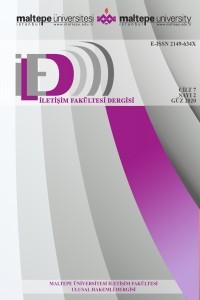“Liberter Medya Yaklaşımı” Üzerine Bir Değerlendirme
Küreselleşme, liberter medya, kamu tekeli, medya sektörü
An Evaluation of “Libertarian Media Approach”
Globalism, libertarian media, public monopoly, media sector,
___
- ARDITI, Benjamin (2004). Liberalizmin Kıyılarında Siyaset, İstanbul: Metis. BOSTANCI, Mehmet Naci (1998). Siyaset ve Medya, Ankara: Vadi Yayınları. BRIDE, MacBride Commission (1980). “Many Voices, One World”, UNESCO, New World Information and Communication Order. FRED S, Siebert; PETERSON, T.; SCHRAMM, W. (1963). Four Theories of the Press: The Authoritarian, Libertarian, Social Responsibility and Soviet Communist Concepts of What the Press Should Be and Do. USA: Urbana&Chicago. LACLAU, E., and MOUFFE, C. (2014). Hegemony and socialist strategy: Towards a radical democratic politics. Verso Trade. McQUAIL, Denis (1987). Kitle İletişim Kuramı (Giriş), Eskişehir: Anadolu Üniversitesi. McQUAIL, Denis (2014). Mass Communication Theory, University of Amsterdam, sixth Edition. London: Sage. MEYER, Thomas (2002). Medya Demokrasisi (Çev. Ahmet Fethi), İstanbul: Kalkedon Yayıncılık, Türkiye İş Bankası Kültür Yayınları. MOUFFE, C. (Ed.). (1999). The Challenge of Carl Schmitt. Verso. ÖZİPEK, Bekir Berat, (2003). Teorik ve Pratik Boyutlarıyla İfade Hürrriyeti, Liberal Düşünce Topluluğu, Ankara. Samsun Gazetesi (Aralık 2013). TAŞKIRAN, Nurdan Öncel (2007). İnsan Gerçekliği ve Medya Eleştirileri, İstanbul: Beta Yayınları. http://www.zaman.com.tr/dunyacinde-cakmagazeteciavı_2185876.html http://www.tbmm.gov.tr/kanunlar/k5187.html.2013 http://www.mevzuat.adalet.gov.tr/html/95.html
- Yayın Aralığı: Yılda 2 Sayı
- Başlangıç: 2014
- Yayıncı: Maltepe Üniversitesi
Eğitim Haberlerinin Metalaşmasını Reklam ve Reklam Haberler Üzerinden Okumak
Erdal DAĞTAŞ, Mehmet Anıl ÜNAL
“Liberter Medya Yaklaşımı” Üzerine Bir Değerlendirme
Kişilerarası İletişimde Duygusal Bulaşmanın Rolü: Öğretmen Öğrenci İletişimi Üzerine Bir Araştırma
Sinemada Zamanın Kullanımı: Slumdog Millionaire Filminde “Oyun” Zamanları - “Zaman” Oyunları
